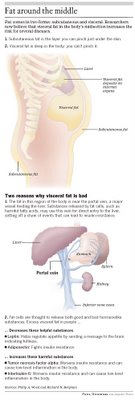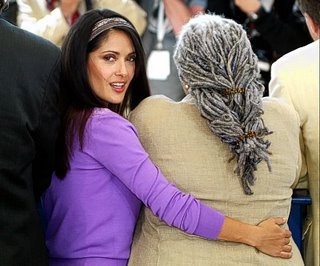A noxious type of fat raises risk for heart disease, diabetes and more. Luckily, it's easy to rid with exercise.
By Shari Roan, Times Staff Writer
April 24, 2006
HAVING a little paunch is just no good with a Speedo or bikini. Health-wise, it's none too pretty either.
That bulge is the outward sign of a deeper problem: visceral fat, a kind of biological monstrosity that, in excess, wreaks havoc on the body, raising the risk for heart disease, diabetes, possibly even dementia and some types of cancer.
Lying deep inside the body, wrapping around the liver and other major organs, visceral fat acts like a kind of organ itself — spewing out bad hormones and squashing the production of good ones. It sets up the body for sickness as the years roll by and additional fat accumulates.
"Visceral fat is very bad for you," says Richard N. Bergman, a professor at USC's Keck School of Medicine. "It seems to have a more negative outcome on health than overall fat."
The evidence now is so compelling that some experts suggest it's time to forget about scales and weight loss and focus on waists and "inch loss."
Luckily, visceral fat doesn't appear to be a particularly stubborn enemy. Health experts have discovered that consistent, moderate exercise by itself appears to help the body rid itself of vast amounts of deep abdominal fat — even when the scales show the pounds aren't dropping very fast.
This emerging science carries a message for consumers: Measure your waist circumference. And reduce it if need be. Doing something about that paunch could help save your life.
Recent studies on visceral fat help explain a well-established fact: that having a pear shape is more healthful than having an apple shape. A pear shape is caused by subcutaneous fat resting just under the skin. Apple is caused by the deep, visceral fat. What this means is that although both types of people — apple and pear — can be overweight, the person with the apple shape has more health risks.
It also means that people with normal weight can be at a higher health risk without realizing it.

Most people gain abdominal fat with age, but research shows the tendency to put on weight around the middle may be inherited. A study published this month in the Proceedings of the National Academy of Sciences identified particular genes that appear to dictate how fat develops and where it's stored.
A long list of illnesses
Meanwhile, the evidence for visceral fat's ill effects is mounting.
In research published in November in the Lancet, doctors concluded that a person's waist measurement is a more accurate predictor of heart attack than the body mass index, or BMI, which is a weight-to-height ratio.
Analyzing data from 27,000 people in 52 countries, the scientists found that BMI measurements were only slightly higher among people who had had heart attacks compared with those who hadn't. But heart attack sufferers had a much higher waist-to-hip ratio (a measurement that reflects abdominal fat) compared with those who hadn't, regardless of other cardiovascular risk factors. This finding was true for men and women in every ethnic group.
"This was the first study that really documented this relationship across all ethnic groups," says Dr. Arya M. Sharma, a co-author of the study from McMaster University in Hamilton, Ontario, Canada, and director of the Canadian Obesity Network.
Other studies have linked visceral fat to metabolic syndrome — a grouping of risk factors, such as high cholesterol and high blood pressure, that can precede diabetes and heart disease. For example, Wake Forest University researcher Barbara Nicklas published a study in 2004 showing that among overweight, post-menopausal women, those with the most abdominal fat were the most likely to have metabolic syndrome.
Additional illnesses may be influenced by excess abdominal weight too. A Kaiser Permanente study presented earlier this year at an obesity conference showed that people with the most abdominal fat were 145% more likely to develop dementia compared with people with the least amount of abdominal fat.
Research has also linked deep abdominal fat to the development of gallstones and breast cancer in women and overall risk of premature death in men. In a study of 291 men published online earlier this month in the journal Obesity Research, doctors found that men with more abdominal fat died in greater numbers, independent of all other risk factors the scientists examined. A man with 2.2 pounds of visceral fat has double the risk of death compared with a man with 1.1 pounds of fat.
Fat's harmful factors
Experts aren't sure why fat can be bad in one area of the body and yet not so bad in others. But they have two strong theories. One has to do with what visceral fat does. The other has to do with where it's located.
Today scientists know that fat is more than just inactive blubber. Fat cells were once thought of as inactive storage units containing a droplet of oil — the fat — that expand in a person who is gaining weight and shrink with weight loss. Now researchers have adopted a more complex picture of fat cells as mini-endocrine factories that produce a range of good and bad substances.
"Once we got beyond the bag-of-fat concept, we found there were a lot of things going on with those cells," says Philip A. Wood, director of genomics at the University of Alabama at Birmingham and author of the book "How Fat Works."
Scientists now know that fat churns out an array of hormones.
The first such substance was discovered in 1994. Researchers identified a hormone, leptin, which is made by fat cells to signal a feeling of fullness.
Researchers now think that leptin, which plays a helpful role in regulating weight, goes down in people with excessive abdominal fat — leading people to eat more and pack on the pounds.
Visceral fat cells make another beneficial hormone, adiponectin, which helps insulin pull sugar from the bloodstream into cells to be used for energy or stored. This also declines as visceral fat levels go up. That can lead to insulin resistance, a condition in which cells no longer respond properly to insulin and which can lead to diabetes.
"Adiponectin going down is exactly what we don't need to happen," Wood says.
Visceral fat also causes some harmful substances to surge, including two proteins called interleukin-6 and tumor necrosis factor-alpha. These substances are bad players because they are thought to incite chronic, low-level inflammation in the body.
"Inflammation itself is not bad," says Nicklas, an associate professor of internal medicine at Wake Forest. "When our bodies are injured or sick we need that to heal. But there is an underlying degree of chronic inflammation with excess abdominal fat." Chronic inflammation aggravates heart disease.
This ability to promote low-level inflammation in the body may in part explain why excessive visceral fat is linked to a higher risk of dementia, says Rachel Whitmer, a research scientist with the Kaiser Permanente Division of Research in Oakland.
In a recent study, Whitmer examined data from more than 6,700 people who were measured for abdominal obesity at ages 40 to 45 and were followed for more than 20 years. Those with the highest amounts of abdominal fat were much more likely to develop dementia. "Being overweight is not only bad for your heart, it's bad for your brain," she says.
Whitmer's theory is that inflammatory substances released by visceral fat may enter the brain and damage nerve cells, contributing to cognitive decline.
Visceral fat may be worse than fat in the hips or buttocks not just because of the substances it makes — but because of its location. It sits near the portal vein, a major vessel that carries blood from the abdominal organs. "Visceral fat dumps its products into this vein that goes right into the liver," Bergman says.
These substances include free fatty acids — fat that circulates in the bloodstream — which appear to make the liver produce too much sugar, upsetting the body's ability to produce the right amount of insulin. This sets up the body for insulin resistance and possibly Type 2 diabetes.
The discovery that excess visceral fat functions almost like an organ, actively producing substances that can ultimately affect overall health, has changed the way many doctors now think about obesity.
"For an obese person with metabolic risks, we probably need to treat what the fat is doing to them, as opposed to trying to get them to lose weight," Nicklas says. "The idea is treating the symptoms of obesity rather than the obesity itself."
And the first step in that process could be pulling out an old-fashioned tape measure.
A simple test
Measuring the waistline with a tape measure hasn't been in vogue since the days of the girdle. Yet increasing numbers of researchers — including the Obesity Society, a major research group — are saying that waist measurements should be part of every checkup.
"You go to the doctor and get your height and weight measured all the time, but physicians don't measure the waist," says Nicklas. "I think it should be measured."
Some weight-loss groups are making waist measurement part of the weekly weigh-in. At Lindora weight-loss clinics, waist circumference is measured each week along with weight loss. It can end up being a positive experience, says Dr. Joseph Risser, director of clinical research at Lindora Medical Clinics. Studies show most dieters tend to have inflated estimates of how much weight they can or will lose. It can be discouraging when the pounds don't melt away.
But, Risser says: "People are encouraged by seeing changes in inches even without losing weight. If they go down a couple of dress sizes or pant sizes, even if the scale shows only 10 or 15 pounds [of weight loss], they are encouraged by that."
Having a tape measure wrapped around his middle was embarrassing at first, admits John Fiore, 47, a Laguna Niguel man who enrolled in a Lindora program in December.
But, he says, waist measurements have helped him appreciate his healthful new approach to eating and exercise. Along with a 64-pound weight loss, Fiore has lost 6 inches around his waist. Moreover, a recent ultrasound scan of his abdomen showed that he lost the large cluster of fat around his liver.
"I know it's important, at my age, to lose that weight around the middle," he says. "My clothes fit better too."
At least it's not stubborn
That is probably the best news about visceral fat: It's not all that hard to lose, and losing even a little might make a big difference in cardiovascular health. Sit-ups and liposuction won't work (sit-ups merely tighten the muscle and liposuction only removes subcutaneous fat), but studies show that regular diet and exercise can lead to a substantial drop. "It's easier than reducing any other fat because the abdominal fat is metabolically very active," Sharma of McMaster University says.
In fact, studies show that people who lose only 10% to 15% of total body weight can still lose up to 30% of their visceral fat — and reap fast, important benefits. A 2001 study published in the American Journal of Clinical Nutrition showed that white and black women on a diet-and-exercise program lost 41% and 37% of their visceral fat, respectively, with a total weight loss of about 15%.
And in a study of 564 patients at Lindora, Risser found that reducing the waistline correlated with drops in blood pressure, cholesterol levels and blood sugar.
Ultimately, scientists hope that efforts to understand how visceral fat functions may lead to medications that target it and its byproducts. One drug under investigation, rimonabant, has been shown to help reduce waist circumference. For now, however, exercise may be the most effective way to reduce abdominal fat.
A study published in 2003 in the Journal of the American Medical Assn. found that people who exercised moderately for a year lost from 3.4% to 6.9% of intra-abdominal fat. The new study in Obesity Research finding higher death rates in men with excessive visceral fat also found that those who exercised tended to lose more visceral fat than those using strictly diet.
A third study, from the University of Pennsylvania, found that even among women who didn't diet, a twice-a-week strength-training regimen still helped slow the amount of visceral fat gained over two years.
"Visceral fat is sort of like a checking account: easy in, easy out," Wood says. "Excess peripheral fat, such as fat in the rear end, is like a retirement account. It's not that easy to get out."
*
(INFOBOX BELOW)
Fat around the middle
Fat comes in two forms: subcutaneous and visceral. Researchers now believe that visceral fat in the body's midsection increases the risk for several diseases.
1. Subcutaneous fat is the layer you can pinch just under the skin.
2. Visceral fat is deep in the body; you can't pinch it.
Two reasons why visceral fat is bad
1. The fat in this region of the body is near the portal vein, a major vessel feeding the liver. Substances released by fat cells, such as harmful fatty acids, may use this vein for direct entry to the liver, setting off a chain of events that can lead to insulin resistance.
2. Fat cells are thought to release both good and bad hormonelike substances. Excess visceral fat in people ...
... Decreases these helpful substances*Leptin: Helps regulate appetite by sending a message to the brain indicating fullness.*Adiponectin: Fights insulin resistance.--
... Increases these harmful substances
*Tumor necrosis factor-alpha: Worsens insulin resistance and can cause low-level inflammation in the body.
*Interleukin-6: Worsens insulin resistance and can cause low-level inflammation in the body.
*
Sources: Philip A. Wood and Richard N. Bergman

